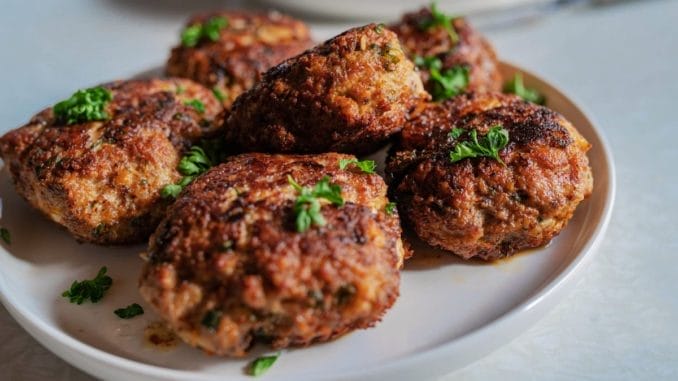
Have you ever wondered what makes Danish Frikadeller so special? These hearty, pan-fried meatballs are more than just a dish—they’re a gateway to Denmark’s rich culinary heritage.
Often referred to as ‘danish meatball', frikadeller are beloved for their rustic charm and melt-in-your-mouth texture, evoking nostalgic memories and cultural significance in Danish cuisine.
Whether you’re curious about the recipe for Danish frikadeller, the history, or the best way to enjoy them, you’re in the right place. Let’s dive into everything you need to know about this iconic Danish delight.
Contents
- 1 What is Danish Frikadeller ?
- 2 Danish Frikadeller Ingredients
- 3 Danish Frikadeller Recipe
- 4 Traditional Danish Gravy
- 5 What to Serve with Danish Frikadeller
- 6 Nutrition Information
- 7 Origins of Frikadeller
- 8 Where to Eat the Best Danish Meatballs in Copenhagen
- 9 Danish Meatballs vs. Swedish Meatballs
- 10 FAQ
- 11 Final Word
What is Danish Frikadeller ?
Frikadeller Danish meatballs, or Danish meatballs, are a beloved comfort food and a staple of traditional Danish cuisine.
These savory, pan-fried meatballs are made from a blend of ground pork and beef, with subtle seasoning that enhances the natural flavors of the ingredients.
Whether served with potatoes, rye bread, or a tangy sauce, Frikadeller have become a symbol of Denmark’s culinary heritage.
Unlike Swedish meatballs, which are often smaller and smoother, Danish Frikadeller are rugged, hearty, and utterly satisfying.
Danish Frikadeller Ingredients
The beauty of Danish Frikadeller lies in their simplicity.
Here are the core ingredients you’ll need to make this iconic dish:
- 250g (9 oz) ground pork
- 250g (9 oz) ground beef
- 1 onion, finely grated
- 1 clove garlic, minced
- 50ml (1/4 cup) milk or sparkling water
- 1 egg
- 50g (1/2 cup) breadcrumbs
- 2 tablespoons all-purpose flour
- Salt and pepper, to taste
- Butter or oil, for frying
When mixing the ingredients, be careful not to overwork the ground meat to maintain the desired texture.
This combination ensures the meatballs are juicy and flavorful while maintaining a tender texture. Some cooks add a pinch of nutmeg or thyme for an extra layer of flavor.
Danish Frikadeller Recipe
Here’s my take on the classic Danish Frikadeller. I’ve tweaked it slightly for ease, but it stays true to the traditional flavors.
These meatballs are perfect for a cozy dinner or as leftovers for an open-faced sandwich the next day.
Steps:
- Mix the Meat Mixture: In a large bowl, combine the ground pork, ground beef, grated onion, and minced garlic. Use your hands or a wooden spoon to mix the ingredients thoroughly.
- Add the Binding Ingredients: Add the egg, breadcrumbs, flour, salt, and pepper. Slowly pour in the sparkling water (or milk) while mixing. The mixture should be moist but hold together well. If it’s too dry, add a little more liquid.
- Chill the Mixture: Cover the bowl and refrigerate the mixture for at least 30 minutes. This helps the flavors meld and makes the meatballs easier to shape.
- Shape the Meatballs: Using a spoon or your hands, form the mixture into oval-shaped meatballs. Aim for a size slightly smaller than a golf ball.
- Fry the Meatballs: Heat a large skillet over medium heat. Add a generous amount of butter or oil to coat the pan. Fry the meatballs in batches, turning occasionally, until they are golden brown on all sides and cooked through. This usually takes about 10 minutes per batch.
- Serve and Enjoy: Serve the Frikadeller warm with your choice of sides, such as mashed potatoes, pickled red cabbage, or a tangy Danish frikadeller sauce. For a rich, flavorful experience, consider serving them with brown gravy.
👉 Pro Tip: Leftovers can be sliced and served cold on rye bread with a dollop of mustard for an authentic Danish lunch.
Traditional Danish Gravy
No Frikadeller meal is truly complete without a generous drizzle of traditional Danish gravy. This creamy and savory sauce begins with a pan of warm, melted butter that serves as the base.
Whisk in heavy cream slowly, allowing the mixture to simmer until it reaches a velvety, thick consistency. Don’t forget the seasoning—a pinch of salt and a few cracks of black pepper are all you need to bring the flavors together.
When served over freshly fried Frikadeller and boiled potatoes, this rich gravy ties everything together in a symphony of taste and texture.
One bite, and you’ll understand why this pairing has been a Danish favorite for generations. It’s comfort food at its finest, and a must-try for anyone exploring the delicious world of Danish cuisine.
What to Serve with Danish Frikadeller
Danish Frikadeller are versatile and pair beautifully with a variety of sides.
Here are some classic options:
- Danish Frikadeller Sauce: A creamy gravy made from the pan drippings, butter, flour, and milk or cream. It’s rich and enhances the savory flavor of the meatballs.
- Mashed Potatoes: Creamy and buttery, they balance the meatballs’ richness.
- Pickled Red Cabbage: A tangy, slightly sweet side that cuts through the heaviness of the dish.
- Rye Bread: For a traditional Danish touch, serve Frikadeller with slices of dense rye bread.
- Egg Noodles: Often served alongside Frikadeller, egg noodles bring a nostalgic connection to family meals.
- Potato Salad: A popular side dish that complements Frikadeller, either served alongside or as part of an open-faced sandwich.
- Sour Cabbage: A traditional side that enhances the meal experience, commonly paired with Frikadeller in Danish cuisine.
Nutrition Information
Frikadeller are more than just a comforting dish—they’re a satisfying way to enjoy a hearty meal.
A typical serving contains around 300-400 calories, 20-25g of fat, and 20-25g of protein. To make a lighter version, you can opt for lean cuts of meat and reduce the butter and cream in the gravy.
Balancing the richness of Frikadeller with sides like boiled potatoes and an array of fresh vegetables can elevate the dish while providing essential nutrients and fiber.
This way, you can savor the classic flavors of Danish Frikadeller guilt-free, knowing you’ve made it part of a wholesome, balanced meal.
Origins of Frikadeller
Danish meatballs, or Frikadeller, have a rich history dating back to the 1600s.
Early recipes described a “sausage without a casing” made with minced meat, seasoned with spices like saffron and ginger, and cooked in soups or stews.
By the 19th century, the invention of the meat grinder and the rise of cast-iron stoves made Frikadeller accessible to everyday households.
These meatballs quickly became a beloved staple, celebrated for their adaptability and heartiness.
Where to Eat the Best Danish Meatballs in Copenhagen
If you’re visiting Copenhagen, don’t miss the chance to try authentic Danish Frikadeller.
Here are three top spots:
- Restaurant Schønnemann: Known for its traditional smørrebrød (open-faced sandwiches), this iconic eatery serves Frikadeller topped with tangy pickled accompaniments. Location: Hauser Plads 16. Visit their site.
- Hyttefadet: A charming restaurant offering classic Danish dishes, including Frikadeller paired with mashed potatoes and creamy gravy. Location: Nyhavn 11. Visit their site.
- Cafe Petersborg: One of the oldest restaurants in Copenhagen, it’s famed for its rustic ambiance and perfectly pan-fried Frikadeller. Location: Bredgade 76. Visit their site.
Danish Meatballs vs. Swedish Meatballs
At first glance, Danish Frikadeller and Swedish meatballs may seem similar, but they have key differences.
- Danish Frikadeller are typically larger, oval-shaped, and pan-fried to achieve a slightly crispy exterior. They’re made with a mix of pork and beef, often flavored with onion and garlic, and served with savory sides like red cabbage or gravy.
- Swedish meatballs, on the other hand, are smaller and smoother in texture. They’re traditionally served with lingonberry jam and creamy mashed potatoes. While both dishes are delicious, Danish Frikadeller have a heartier, more rustic charm that reflects Denmark’s culinary roots.
FAQ
What is the difference between Danish Frikadeller and Swedish meatballs?
Danish Frikadeller are typically flat and pan-fried, while Swedish meatballs are round and often served in a creamy sauce.
Danish Frikadeller are made with a mixture of ground pork and beef, whereas Swedish meatballs usually combine ground beef and pork. Both are delicious, but they offer distinct textures and flavors.
Can Frikadeller be made in advance?
Yes, Frikadeller can be prepared ahead of time and stored in the refrigerator or freezer.
Shape the meat mixture into patties, then refrigerate or freeze until you’re ready to cook. This makes them a convenient option for meal planning.
What is the best way to serve Frikadeller?
Frikadeller are traditionally served as a main course with boiled potatoes, gravy, and vegetables.
They can also be enjoyed on rye bread with pickles and remoulade, or as part of a smørrebrød (open-faced sandwich). The versatility of Frikadeller makes them a beloved dish in Danish cuisine.
Final Word
There’s something magical about cooking a dish that’s been loved for centuries. Danish Frikadeller are more than just a meal—they’re a connection to Denmark’s rich history and culture.
Why not bring a taste of Denmark into your home tonight? Fire up your skillet, gather the ingredients, and let the aroma of sizzling Frikadeller transport you straight to the heart of Copenhagen. Your culinary adventure is just a bite away!





Be the first to comment